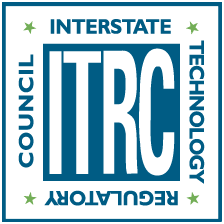
| Indoor Air Treatment Removing Chemical Vapors from Indoor Air ITRC has developed a series of technology information sheets that summarize building mitigation technologies related to vapor intrusion (VI). The purpose of this technology information sheet is to describe how air treatment units can be used as a rapidly installed technology to mitigate VI. This sheet provides general applicability and design considerations, typical configurations, advantages and limitations, and cost considerations. |
Overview
Air treatment units, commonly referred to as air purifying units (APUs) or air cleaners, can be used to mitigate vapor intrusion (VI) and are most often used when a temporary reduction of volatile organic compound (VOC) concentrations in indoor air is needed while a longer term mitigation and/or source remediation strategy is designed, permitted, and installed (e.g., sub-slab depressurization system). APUs are intended to actively circulate indoor air within a certain room or building area and remove VOCs present in the air stream. They are considered a versatile, easy-to-implement, short-term solution, but still require some oversight.
APUs can be ineffective if not properly selected for the target compounds or sized for building- and site-specific conditions. Considerable variability in effectiveness has been reported, with reductions of VOC concentrations in indoor air ranging from 25 to 99%. For that reason, follow-up verification testing/performance monitoring may be appropriate when warranted by site conditions (e.g., elevated VOC concentrations, sensitive settings, such as daycares or schools) prior to the installation of the long-term mitigation design. In addition, certain regulatory frameworks may require indoor air monitoring to verify that an APU is meeting its performance objectives. Because VOC contributions to indoor air unrelated to the subsurface may complicate interpretation of indoor air sampling results, additional lines of evidence should also be considered when evaluating performance (e.g., assessment of indoor or outdoor background VOC sources).
Components
Classes of commercially available APUs include the following:
- adsorption-based APUs (i.e., treatment using a sorbent bed or layer, commonly granular activated carbon [GAC])
- photocatalytic oxidation APUs (i.e., use of light and catalysts to break down VOCs into water, carbon dioxide, and other compounds)
- other types, including ozone generation, chemisorption (e.g., permanganate), or biofiltration (using plants or microbes)
Adsorption-based APUs are most common and are discussed further in this information sheet. Primary issues associated with the other classes listed above include the potential for the formation of by-products released to the indoor air (e.g., other VOCs, ozone, hydrochloric acid) and overall lack of verification through peer-reviewed case studies.
APUs can be used in different configurations. Stand-alone APUs include portable (Figure 1), wall-mounted, or ceiling-mounted units. APUs can also be installed within the ducts of an existing heating, ventilation, and air conditioning (HVAC) system. The units are often equipped with particulate filters to supplement the VOC adsorbent material.
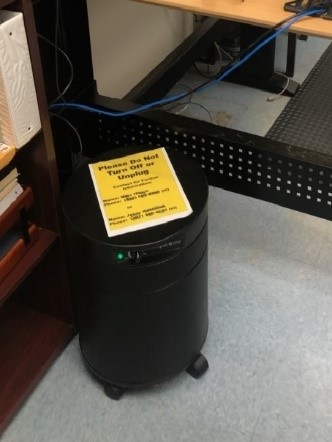
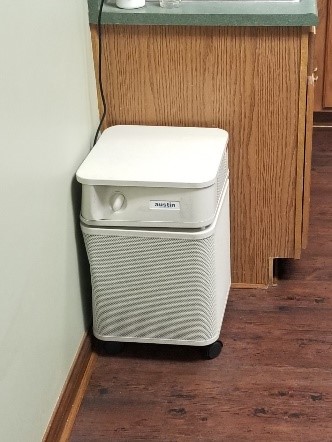
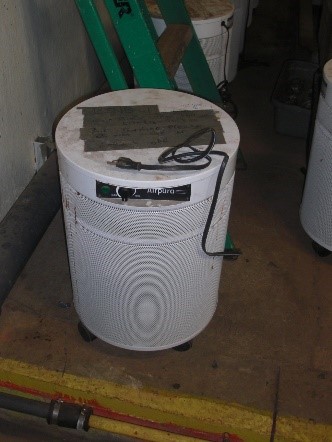
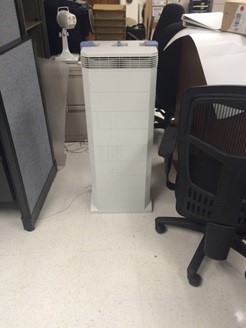
Figure 1. Examples of portable APUs.
(Sources: Jacobs Engineering Group, U.S. Navy, used with permission.)
Typical design specifications for an APU include airflow (for portable units), pressure drop (for duct-mounted units), VOC removal efficiency, sorbent capacity or lifetime, reliability and uptime, noise levels, power usage, physical dimensions, and weight.
Multiple factors should be considered when selecting the number of units and individual capacity of APUs. These factors include:
- chemical characteristics of the air to be treated (e.g., type and concentrations of target VOCs, presence of nontarget VOCs, particles, other air contaminants)
- physical characteristics of air stream (e.g., humidity, temperature)
- building characteristics (e.g., size of space to treat, air exchange rate [AER])
- occupant characteristics (e.g., frequency of occupancy, noise tolerance, acceptance by occupants)
- other characteristics (e.g., power requirements, equipment theft or tampering concerns, equipment visibility and aesthetics)
The number of APUs and individual flow rate should be such that the total airflow is several times the baseline airflow through the space to be treated. The baseline airflow is the amount of air flowing though the space under ambient conditions and can be estimated using the space volume and baseline AER. Typical AERs range from less than one air change per hour in residential settings to a few air changes per hour in non-residential settings. APUs essentially “increase” AER by recycling clean air within the room several times per baseline AER. The expected reduction in VOC concentration can be estimated from the increased AER and an assumed VOC removal efficiency by the APU (i.e., 100% or a lower level). VOC mass loading and GAC consumption should also be considered. The VOC mass loading rate (i.e., the rate of both target and nontarget VOC mass entering the space to be treated) can be estimated from the indoor air concentrations and baseline AER. This mass loading rate can then be used to estimate the amount of GAC needed for treatment and the expected replacement frequency.
Advantages
Advantages associated with APUs include their versatility and ease of implementation in a variety of settings. APUs are well suited for implementing a rapid response. This approach can quickly lower indoor air concentrations to acceptable indoor air quality levels while long-term VI mitigation is designed and implemented. APUs can also be used to supplement an existing mitigation system or installed within an operating HVAC system.
Limitations
There are numerous limitations associated with APUs, which can be summarized as follows:
- APUs treat indoor air and, therefore, do not cut off the VI pathway or address the VOC source.
- The treatment GAC ultimately needs to be replaced or regenerated, and may create waste, with special disposal considerations in areas of high radon potential.
- APUs can be noisy and subject to human interference (i.e., unit turned off or doors shut, interfering with the treatment of air in other rooms).
- APUs can be maintenance- and power-intensive and costly to operate to meet performance objectives.
- Adsorption performance can be limited by moist environments and competition from nontarget VOCs, which are common in indoor air due to a variety of sources (e.g., cooking, upholstery, consumer products).
- APUs can be ineffective or may not achieve indoor air criteria for VOCs with poor adsorption performance (e.g., vinyl chloride) or when indoor air concentrations are high.
- Overall performance is subject to uncertainty, such that follow-up verification testing and the development of a performance monitoring plan may be appropriate when warranted by the severity of the conditions (e.g., elevated contaminant concentrations, daycare or school settings) prior to the installation of the long-term mitigation design.
Cost Considerations
Portable APUs can be purchased at costs ranging from about five hundred to a few thousand dollars. Replacement GAC filters or particulate filters are typically less than three hundred dollars. The overall price will depend on the number of units needed and filter change-out frequency.
Special Circumstances
As indicated previously, certain classes of APUs use photocatalytic oxidation (in lieu of adsorption) to transform VOCs into water, carbon dioxide, and other compounds. These APUs use ultraviolet light and a catalyst (commonly, titanium dioxide). Laboratory and field studies have shown that VOCs can be effectively broken down, assuming enough air passes (recirculates) through the units. Some studies, however, have also shown the formation of intermediate oxidation products, including acetone, formaldehyde, and others. Because multiple air passes are needed before complete breakdown of the VOCs is achieved, building occupants could potentially inhale these by-products while the APUs operate in the space that is treated.
Occupant, Community, and Stakeholder Considerations
It is essential to develop and implement a site-specific community involvement plan that addresses, among other things, how to win trust and gain access to properties, communicate risk to potentially exposed individuals, and minimize the disruption of people’s lives and businesses. For more details see ITRC’s Public Outreach during Vapor Intrusion Mitigation Fact Sheet.
Resources
- Interstate Technology and Regulatory Council (ITRC). 2007a. Vapor Intrusion Pathway: A Practical Guideline, Washington, D.C., January.
- ITRC. 2014. Petroleum Vapor Intrusion, Fundamentals of Screening, Investigation, and Management, October.
- Schumacher, B., J.H. Zimmerman, R. Truesdale, K. Owen, C. Lutes, M. Novak, and K. Hallberg. 2017. Adsorption-based Treatment Systems for Removing Chemical Vapors from Indoor Air. U.S. Environmental Protection Agency, Washington, DC, EPA/600/R-17/276, June.
- U.S. Environmental Protection Agency (US EPA). 2018. Residential Air Cleaners: A Technical Summary. Office of Radiation and Indoor Air, Indoor Environments Division, 3rd Edition, EPA 402-F-09-002,
Related Links:
For more information and useful links about VI pathways and mitigation technologies, go to http://www.itrcweb.org/.

[email protected], 919-707-8279 Matthew Williams, Michigan Dept. of Environment, Great Lakes, and Energy [email protected], 517-881-8641 |
Click here to view a PDF version of this Tech Sheet.
